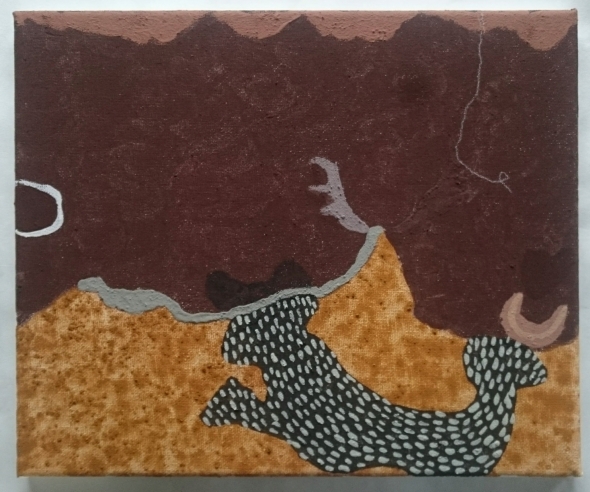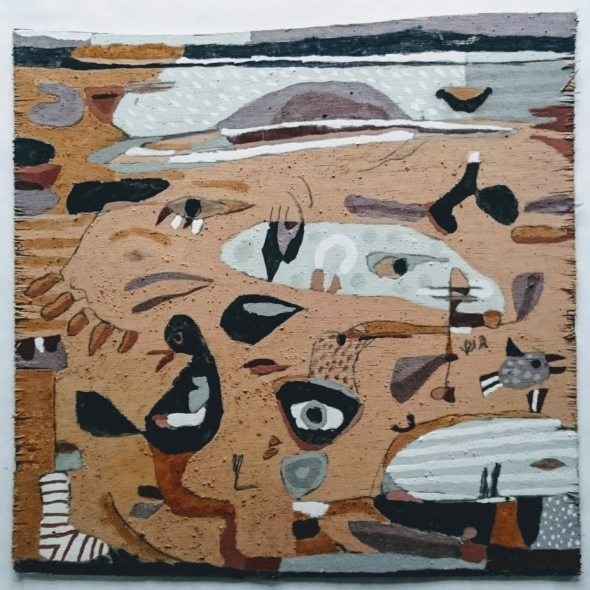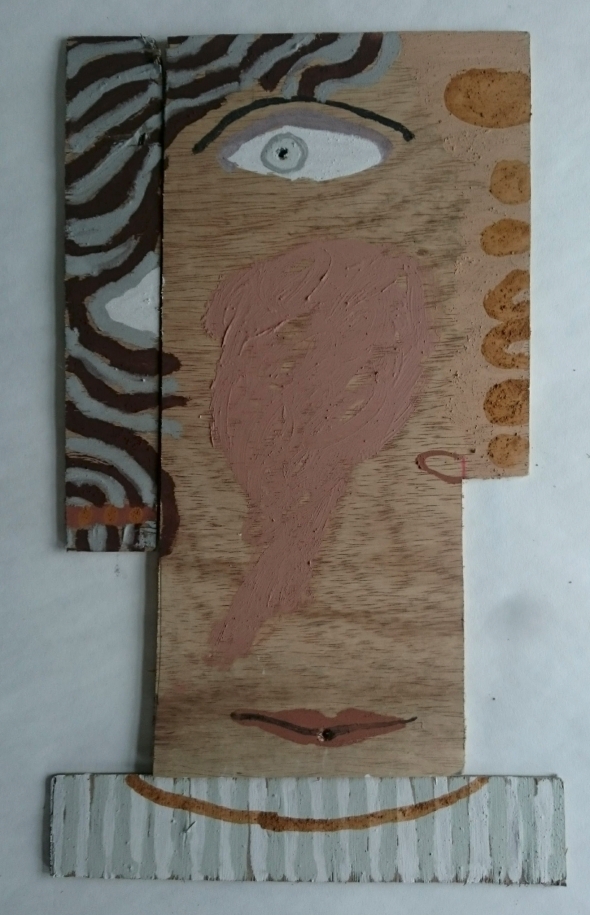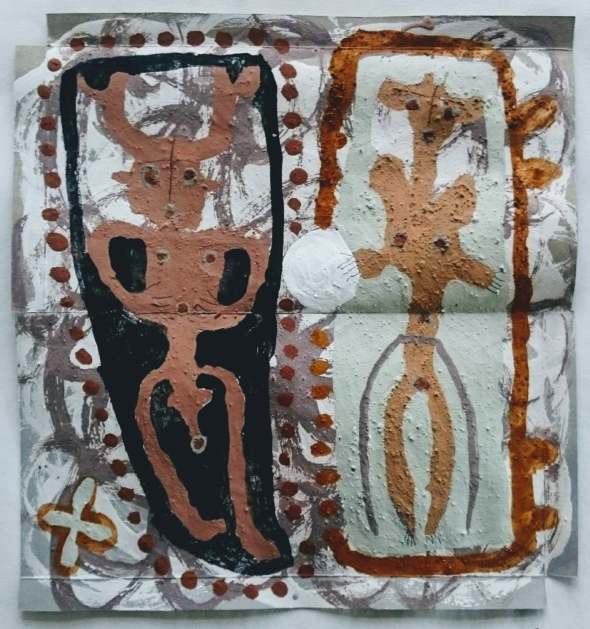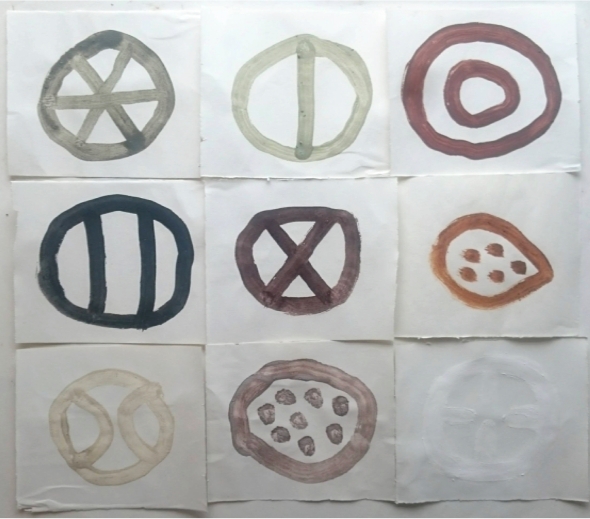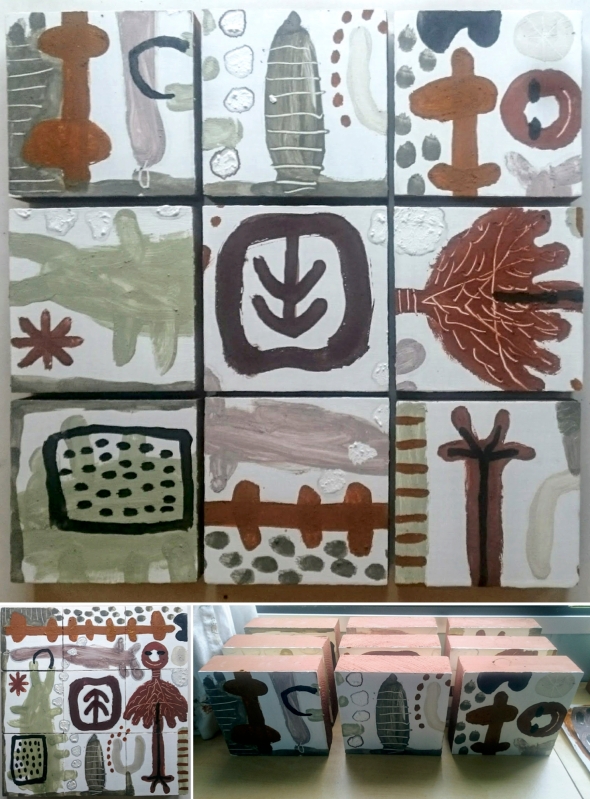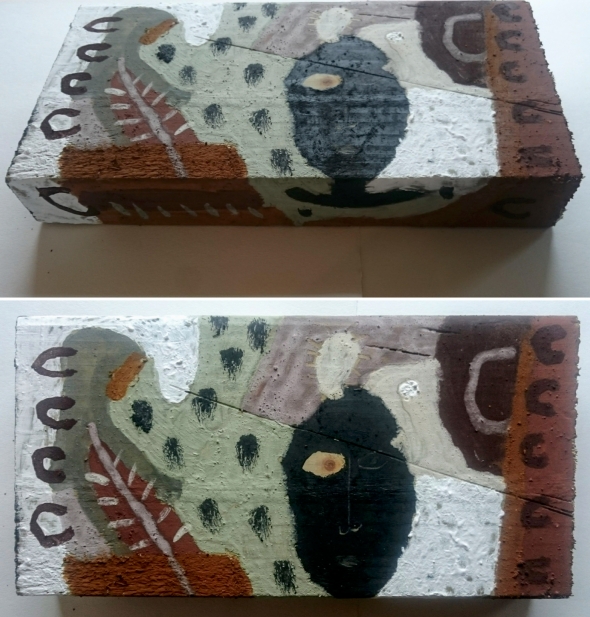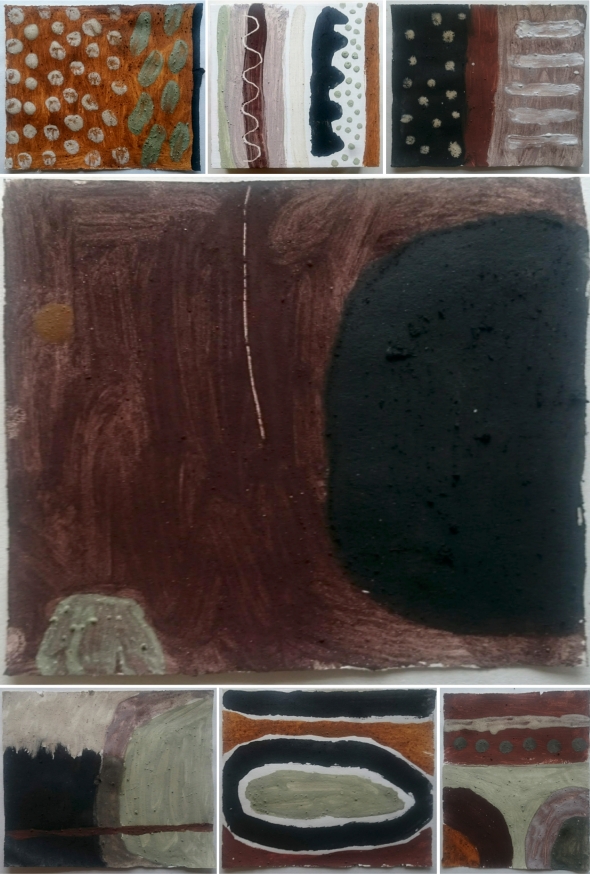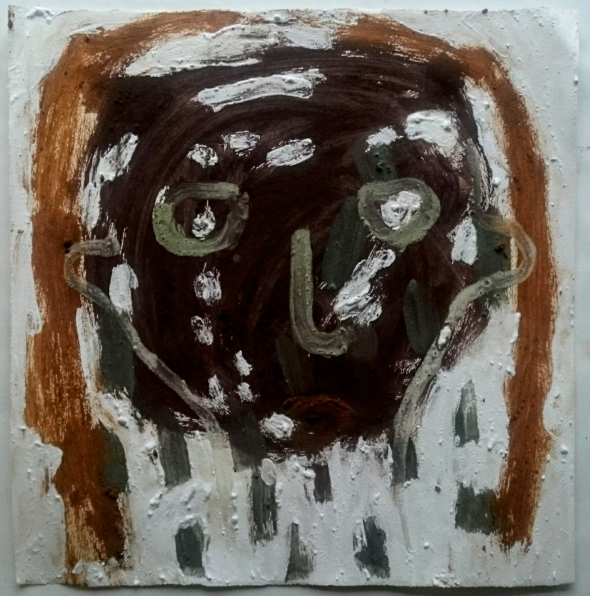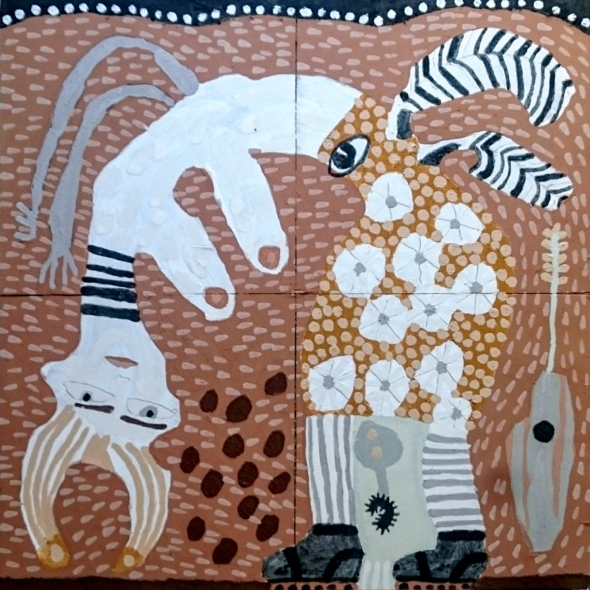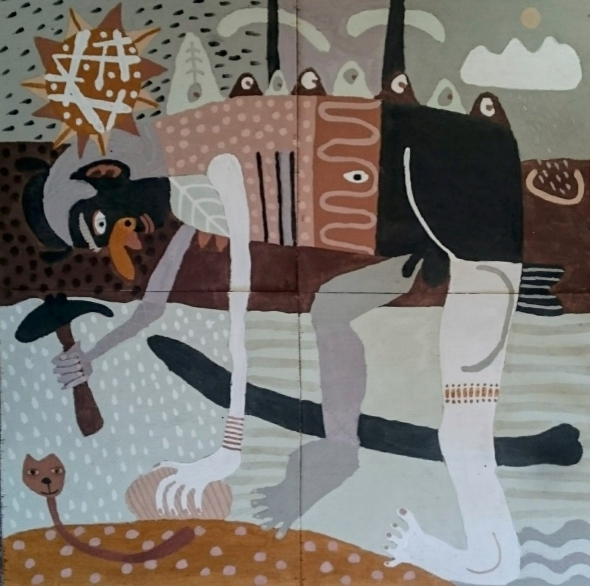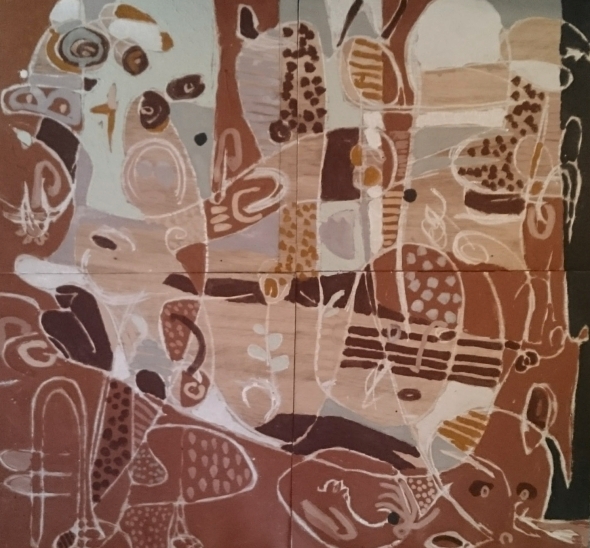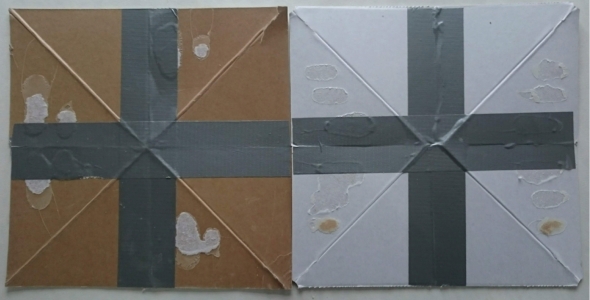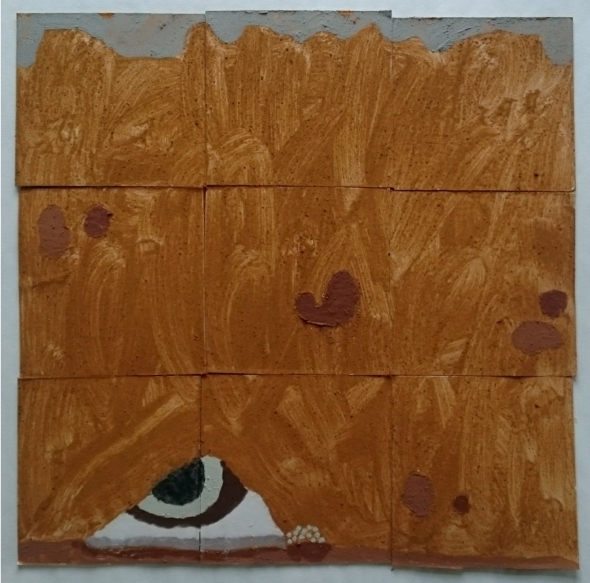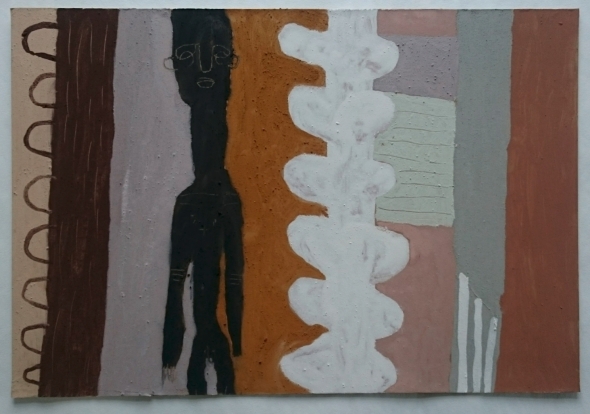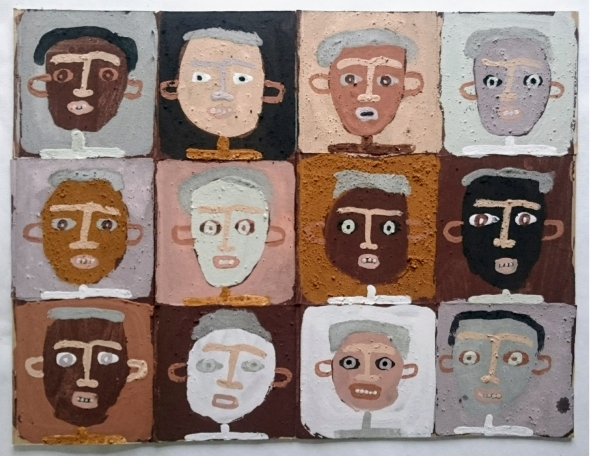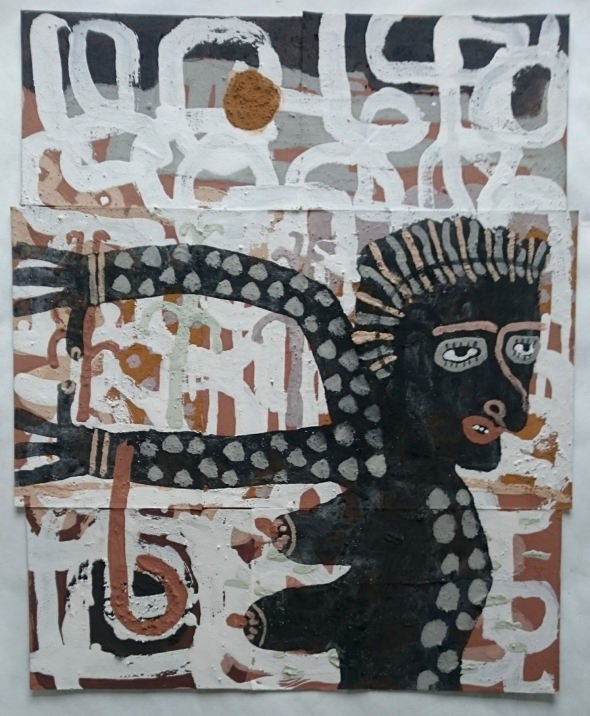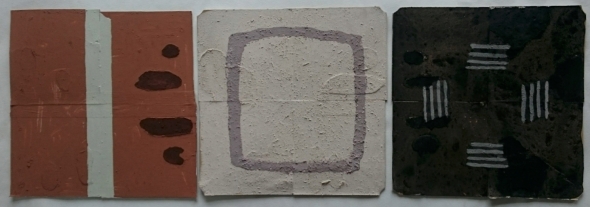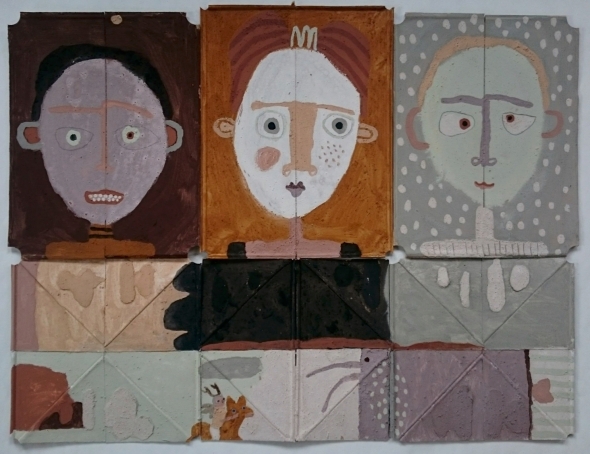no light no colour no more
Posted: February 25, 2019 Filed under: eARTh | Tags: Aesthetics, art and science, Arte Povera, Arts, arts research, Cornwall, earth pigments, eco art, ecopsychology, Environmental art, Feeling, indigenous culture, painting, Pigment, Visual arts 2 Commentsfurther material responses to existential emergence, crisis and change
I was reminded recently, while gazing fleetingly into the shimmering turquoise green blue ocean here in West Cornwall, of my early art training based in the classical understanding of colour. colour as light. a systematic mixing together of homogenous materials to represent the colours that we observe in Nature from a set of ‘primaries’: reds, blues and yellows. no black. white in moderation. of hue.
 iron board, Praa Sands, Cornwall (Cornish earth pigments on rock) © p ward 2019
iron board, Praa Sands, Cornwall (Cornish earth pigments on rock) © p ward 2019
our perception of colour, of light and shade, and hence of depth, size, form and materiality, is sometimes explained as the processing and communication of visual information created by the reflection, refraction and absorption of light in relation to materials. working with earth pigments has revealed ‘colour’ as more than just a visual ‘scientific’ process of perception. it is more a holistic appreciation of material presence which encompasses not just colour but texture, smell and a provenance of time and place, of formation and decay, of ecology, history and Nature itself.
we may often associate earth colours with a range of browns, reds and yellows. with this latest set of paintings I have been enjoying a more subtle selection of greys, greens, mauves and whites that I have found, gathered and mixed near my home.
I could say that the stories they tell are unique expressions of their own experience that I have been privileged to bring into contemporary form, but maybe that is for you to decide…
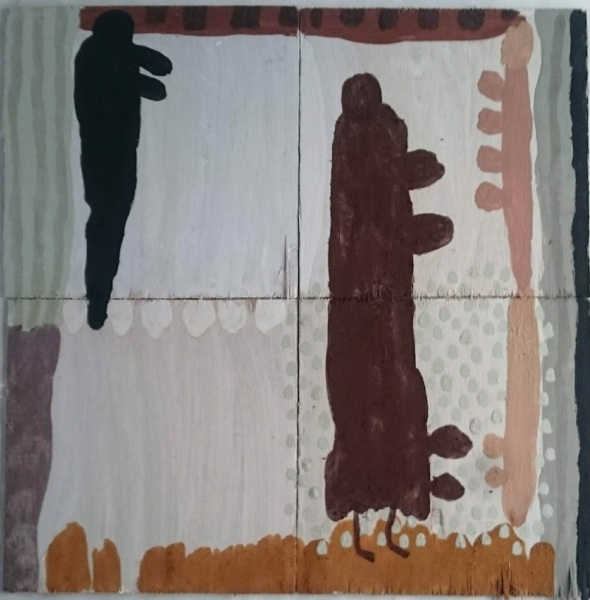 aspects of landscape and love – today it snowed (Cornish earth pigments on board; 51x51cm) © p ward 2019
aspects of landscape and love – today it snowed (Cornish earth pigments on board; 51x51cm) © p ward 2019
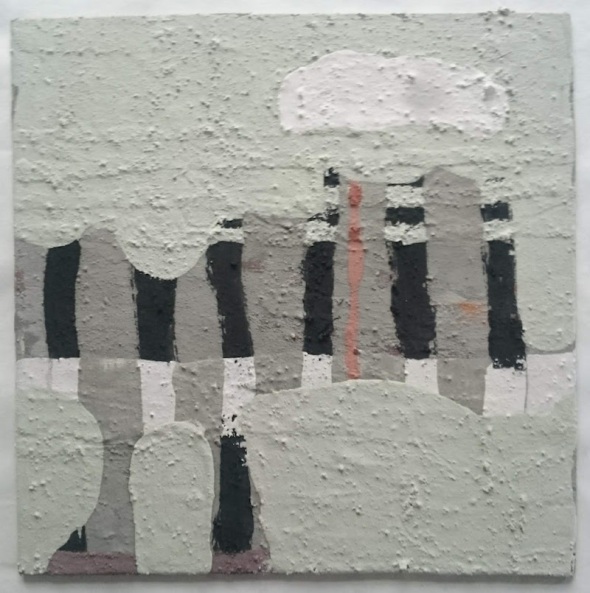 the beautiful things that people say when they are together (Cornish earth pigments on board; 25x25cm) © p ward 2019
the beautiful things that people say when they are together (Cornish earth pigments on board; 25x25cm) © p ward 2019
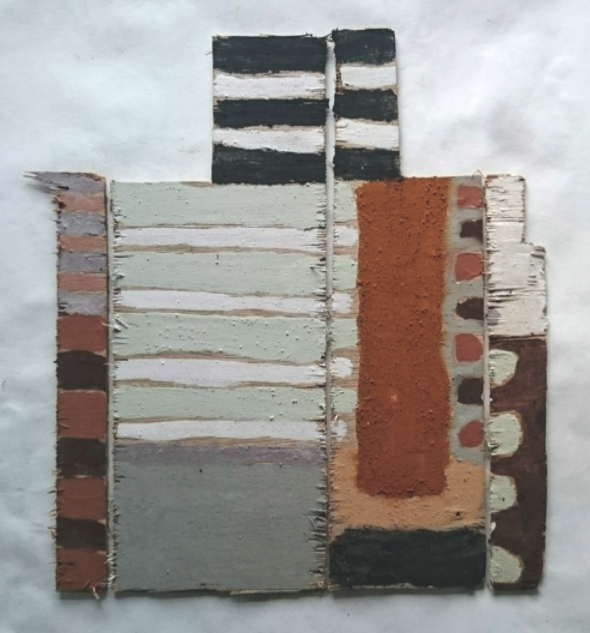 facing up to facing up to (Cornish earth pigments on board; 31x33cm) © p ward 2019
facing up to facing up to (Cornish earth pigments on board; 31x33cm) © p ward 2019
 rearranging the furniture (Cornish earth pigments on board; 35x35cm) © p ward 2019
rearranging the furniture (Cornish earth pigments on board; 35x35cm) © p ward 2019
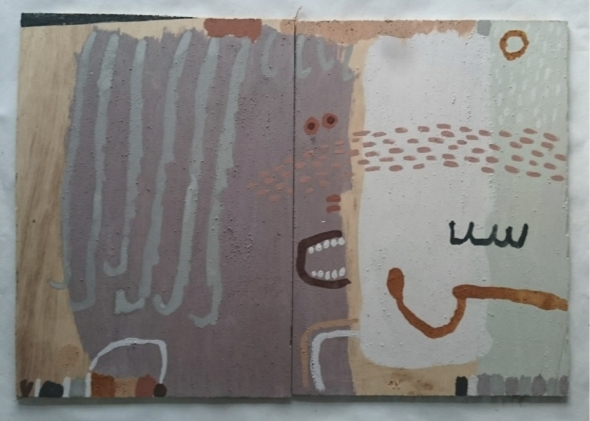 like chopping onions in a northwesterly gale (Cornish earth pigments on board; 56x38cm) © p ward 2019
like chopping onions in a northwesterly gale (Cornish earth pigments on board; 56x38cm) © p ward 2019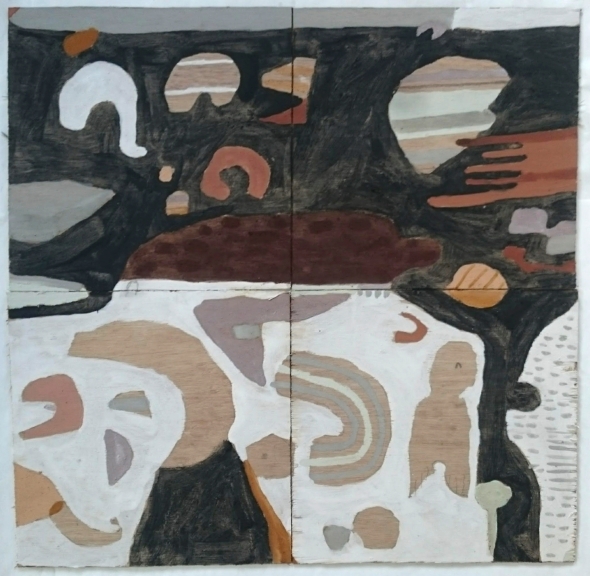 stones that stand in fields with swans and cows and geese: penwith (Cornish earth pigments on board; 70x68cm) © p ward 2019
stones that stand in fields with swans and cows and geese: penwith (Cornish earth pigments on board; 70x68cm) © p ward 2019
 simple communication here (Cornish earth pigments on card; 61x51cm) © p ward 2019
simple communication here (Cornish earth pigments on card; 61x51cm) © p ward 2019
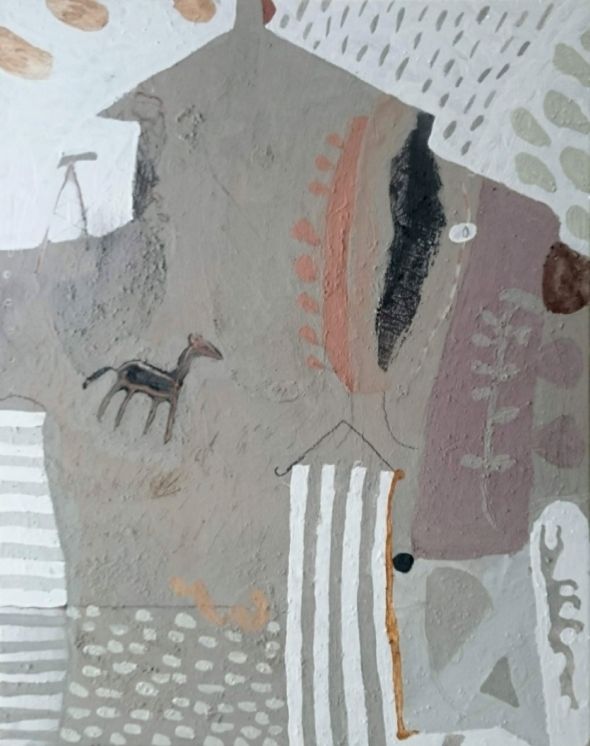 house of power (Cornish earth pigments on canvas; 40x50cm) © p ward 2019
house of power (Cornish earth pigments on canvas; 40x50cm) © p ward 2019
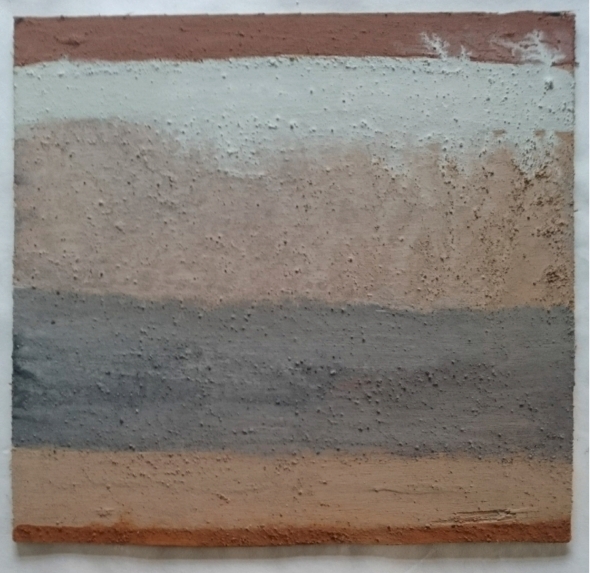 nondescript (Cornish earth pigments on board; 27x26cm) © p ward 2019
nondescript (Cornish earth pigments on board; 27x26cm) © p ward 2019
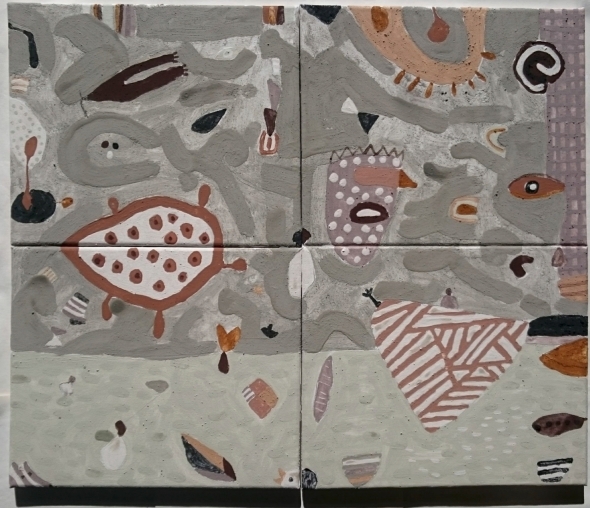 turning a new leaf with foxes on my mind (Cornish earth pigments on canvas; 61x51cm) © p ward 2019
turning a new leaf with foxes on my mind (Cornish earth pigments on canvas; 61x51cm) © p ward 2019
© P Ward 2019
painting within limits
Posted: January 26, 2019 Filed under: eARTh | Tags: Aesthetics, Arte Povera, Arts, arts research, Cornwall, Earth, earth pigments, eco art, ecopsychology, Environmental art, indigenous culture, painting, Pigment, Visual arts 1 Commentnew paintings from Cornwall – early 2019
For many years I have exclusively used colours from the earth in my paintings, gathering and processing all the pigments myself. Each location offers a unique palette and quality of colour to work with as well as a deeper understanding of that place.
To some it may seem as if creativity is being limited. “How can I paint the sky or the trees?” are frequent questions when running workshops. Working with earth pigments has changed the way I work and my understanding of painting in many ways. It has enriched my perception of colour and the ‘material’ of colour. Black is no longer “an absence of light”. For me it allows a specific expression of place orientated, of course, by my own relationship to being there.
The paintings here respond to the nature of earth colours and experiences in West Cornwall…
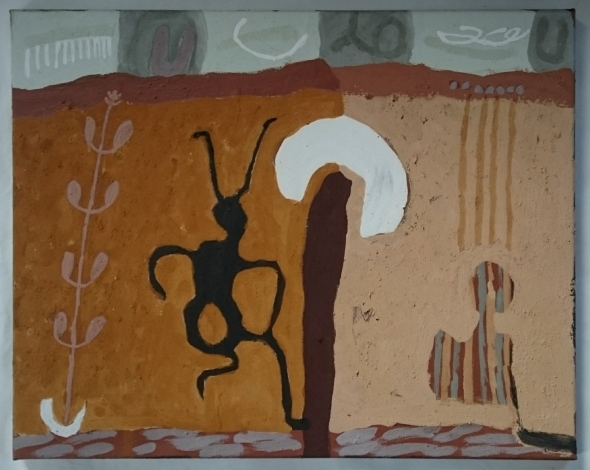 distance what we have become (Cornish earth pigments on canvas; 60x40cm) © p ward 2019
distance what we have become (Cornish earth pigments on canvas; 60x40cm) © p ward 2019
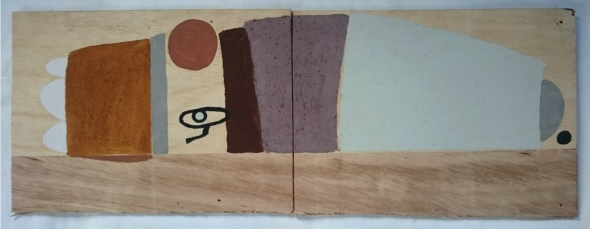 big red wolf moon that I did not see (Cornish earth pigments on board; 76x28cm) © p ward 2019
big red wolf moon that I did not see (Cornish earth pigments on board; 76x28cm) © p ward 2019
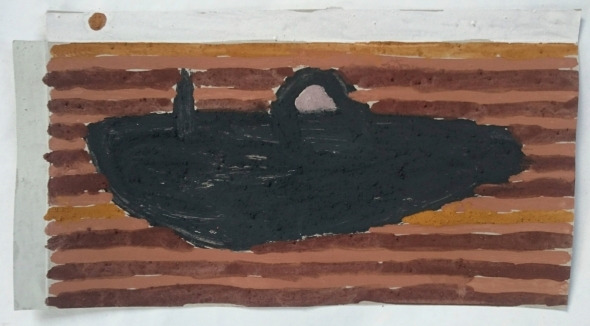 to run aground an island (Cornish earth pigments on card; 27x15cm) © p ward 2019
to run aground an island (Cornish earth pigments on card; 27x15cm) © p ward 2019
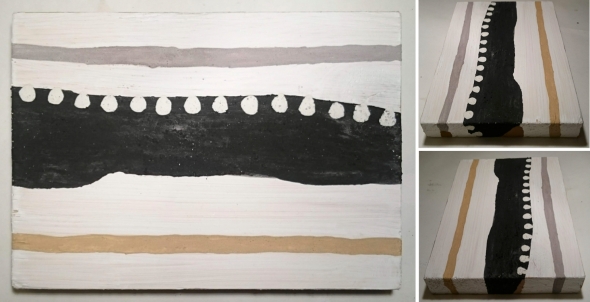 estuary (Cornish earth pigments on wood; 20×14.5x2cm) © p ward 2019
estuary (Cornish earth pigments on wood; 20×14.5x2cm) © p ward 2019
 untitled I, II, III (Cornish earth pigments on board; 25x26cm; 25x28cm; 25x26cm) © p ward 2019
untitled I, II, III (Cornish earth pigments on board; 25x26cm; 25x28cm; 25x26cm) © p ward 2019
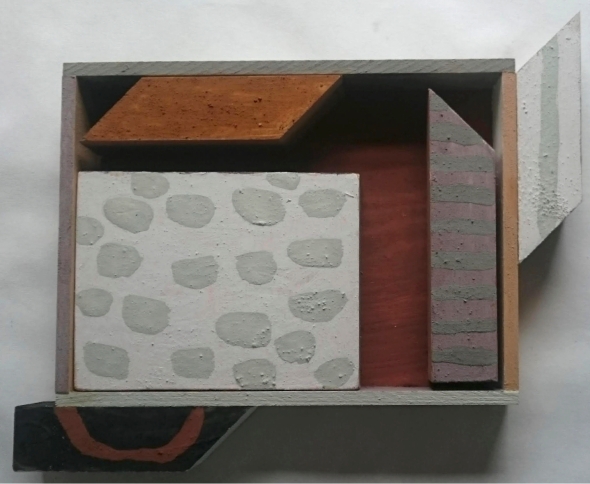 offcuts homestead (Cornish earth pigments on wood; 29x24x3cm) © p ward 2019
offcuts homestead (Cornish earth pigments on wood; 29x24x3cm) © p ward 2019
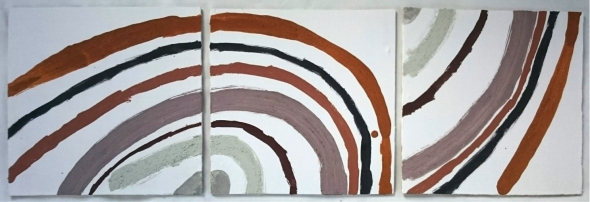 at fault (Cornish earth pigments on board; 80x26cm) © p ward 2019
at fault (Cornish earth pigments on board; 80x26cm) © p ward 2019
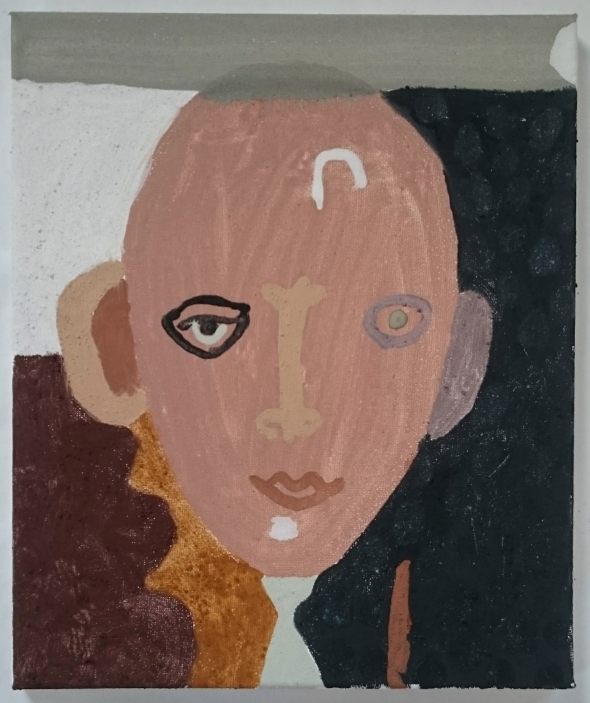 fairy queen (Cornish earth pigments on canvas; 25x30cm) © p ward 2019
fairy queen (Cornish earth pigments on canvas; 25x30cm) © p ward 2019
© P Ward 2019
Pet Portraits with Earth Pigments
Posted: January 25, 2019 Filed under: eARTh | Tags: animal paintings, earth pigments, painting, pet portraits, Pigment, Visual arts Leave a commentI was recently asked to paint some dog portraits for friends and family – something a bit different. It was a good reminder of my own skills as an illustrator and draftsman and an affirmation of the suitability of the pigments for a series of wildlife images I hope to produce sometime soon. I used a combination of Cornish and North Devon earth pigments for the paintings and really enjoyed the results…
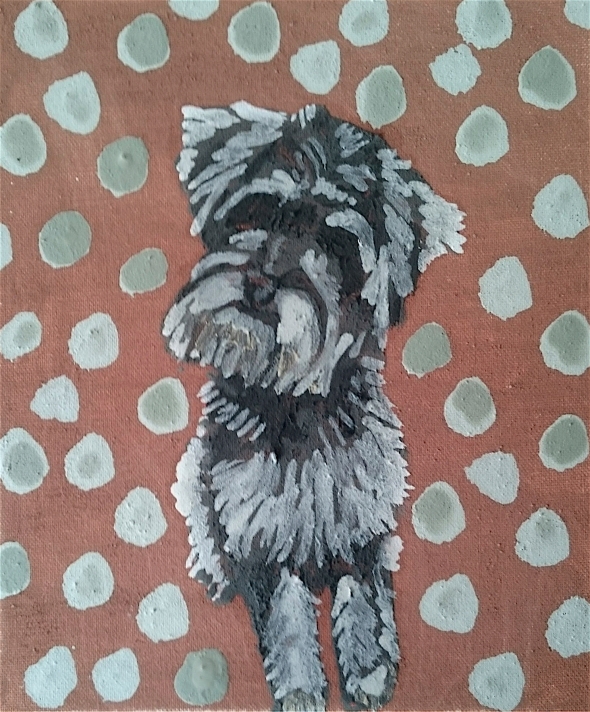 Maggy (earth pigments on canvas; 25x30cm) © p ward 2018
Maggy (earth pigments on canvas; 25x30cm) © p ward 2018
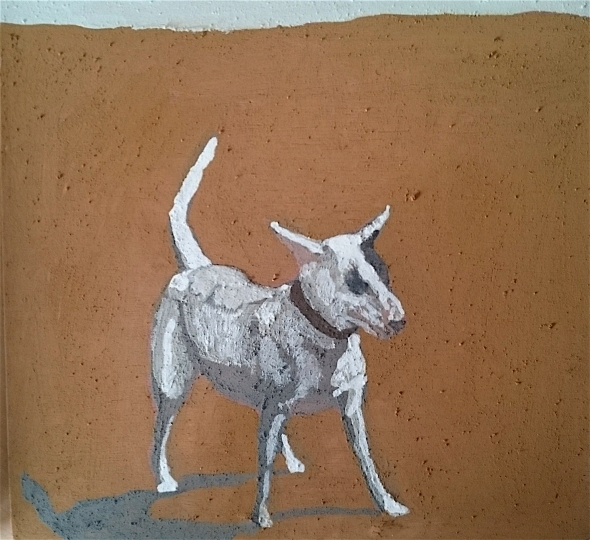 Pearl (earth pigments on board; 28x28cm) © p ward 2018
Pearl (earth pigments on board; 28x28cm) © p ward 2018
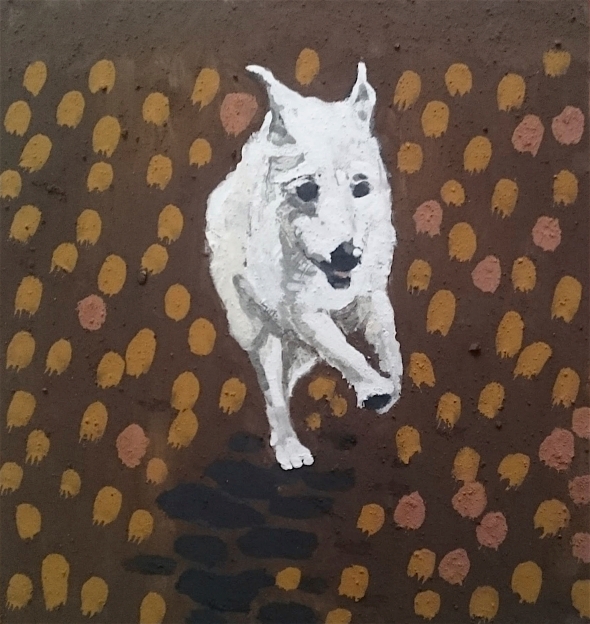 Holly (earth pigments on board; 28x28cm) © p ward 2108
Holly (earth pigments on board; 28x28cm) © p ward 2108
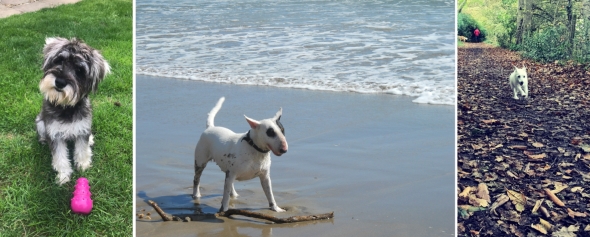 (source photos for dog portraits, courtesy of owners)
(source photos for dog portraits, courtesy of owners)
© P Ward 2019
Painting with Earth – Cornwall: new home, new works
Posted: November 30, 2018 Filed under: eARTh | Tags: Arte Povera, Arts, arts research, Cornwall, earth pigments, eco art, ecopsychology, Environmental art, Feeling, indigenous culture, painting, Pigment, poetry, Visual arts Leave a commentNovember 2018
despite the wind
despite the weather
despite the winter
despite the sense of vulnerability
this raw and new found exposure
despite the twisting and turmoil of our times
despite love
and loss
despite it all
this earth still shines
Before I embark on a new phase of experimentation, combining different binders with the Cornish pigments, I would like to share a few paintings that I have made in my new home – a caravan on a dairy farm in the coastal hills of west Penwith, Cornwall.
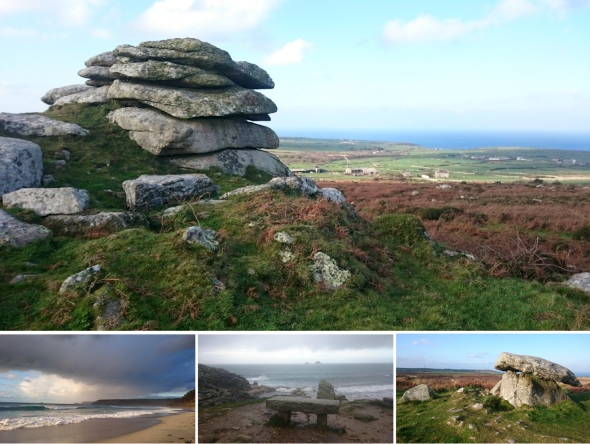 West Penwith, Cornwall – Morvah, Sennen Cove, Cot Valley and Chun Quoit © p ward 2018
West Penwith, Cornwall – Morvah, Sennen Cove, Cot Valley and Chun Quoit © p ward 2018
Here, I am surrounded by the historic land markings of the ancient peoples who populated this extremity of the British Isles. Stone walls, reportedly demarcating some of the oldest working field networks in the world, built 5000 years ago. Iron age hill forts, burial mounds, settlements and wells set in the denuded coastal wasteland of heath and moor. It is at times bleak. After the rain and wind that lashes fresh from the vast Atlantic ocean, the colours of autumn shine. The constantly changing hues of the blue and grey and turquoise sea. Rainbows sitting in our laps. The sky heavy and clear and dark and brooding. Salt water permeating. The animals are exposed by their hunt for food, by the lack of cover afforded by the stripped land. It is a place of spirit and history and life, right now.
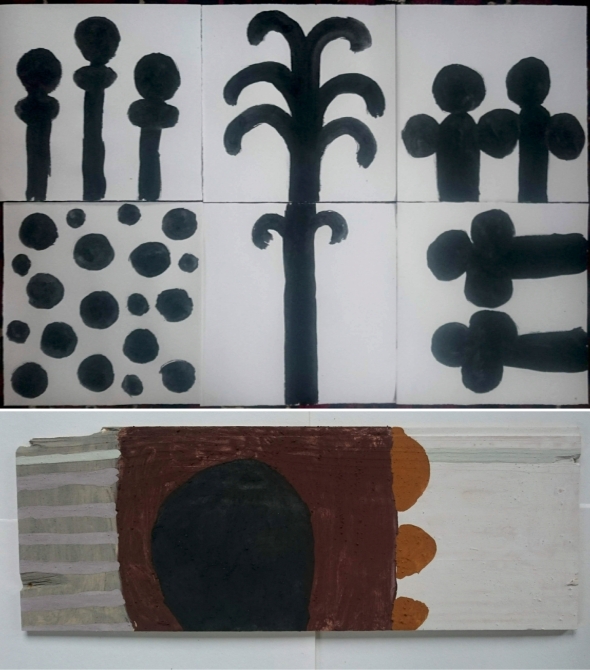 Penwith dream forms (Botallack black on paper); fogou (Cornish earth pigments on wood) © p ward 2018
Penwith dream forms (Botallack black on paper); fogou (Cornish earth pigments on wood) © p ward 2018
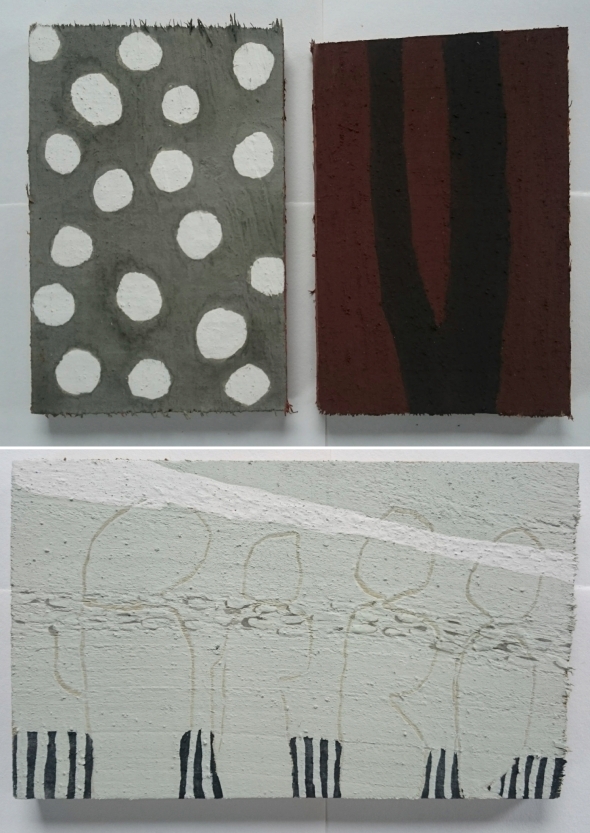 mineral, vegetable; mist (Cornish earth pigments on wood) © p ward 2018
mineral, vegetable; mist (Cornish earth pigments on wood) © p ward 2018
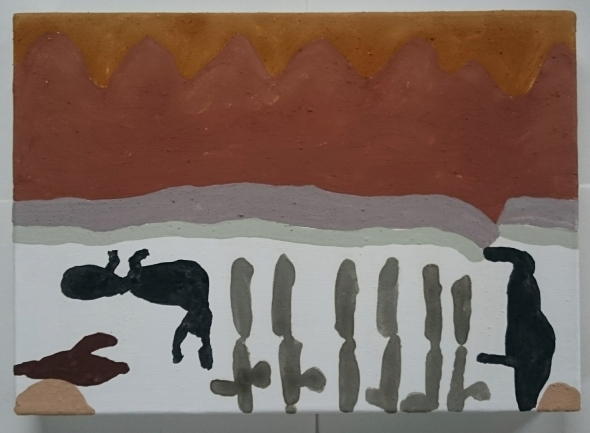 dance on the shore (Cornish earth pigments on canvas) © p ward 2018
dance on the shore (Cornish earth pigments on canvas) © p ward 2018
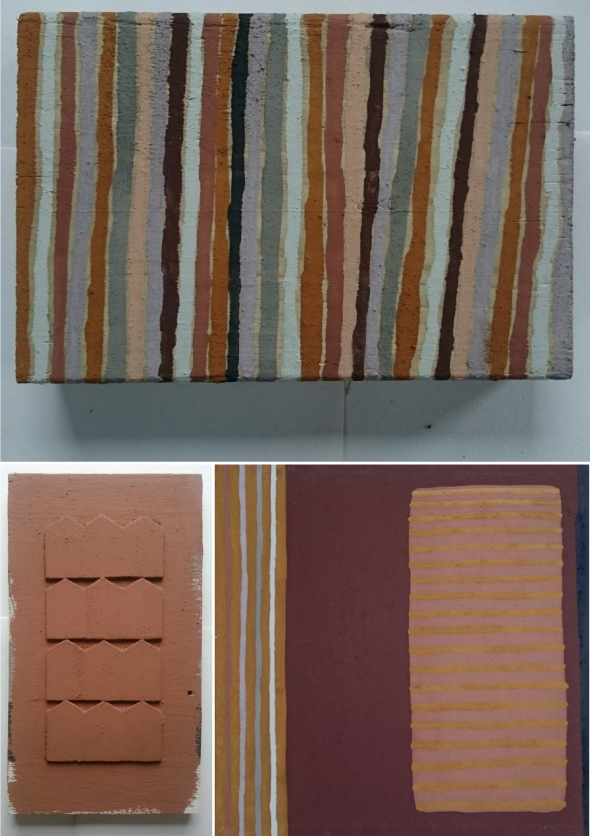 virtually vertical; community (Cornish earth pigments on wood); earth bound (Cornish earth pigments on canvas) © p ward 2018
virtually vertical; community (Cornish earth pigments on wood); earth bound (Cornish earth pigments on canvas) © p ward 2018
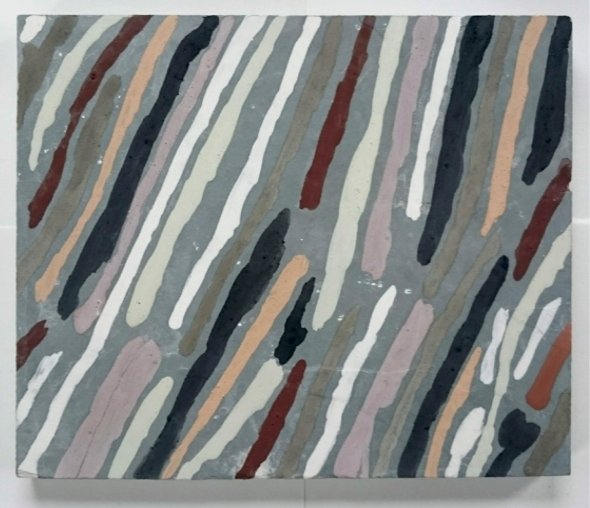 pigment drift (Cornish earth pigments on slate) © p ward 2018
pigment drift (Cornish earth pigments on slate) © p ward 2018
I am slowly learning to listen to the language of the colours here. The earth pigments, their qualities, their sources are unfamiliar. New to me. They are similar in colour to those of North Devon, that I have been using for a long time but very different in other ways. Their formation. Their nature. They have not been part of my own story, until now. The marks and stories they suggest are gradually revealing themselves. Their relationships unfolding. Their dynamic. And despite my attempts at integrity to their provenance and the spirit of this place in which I find myself, it is the freedom of my children’s paintings and drawings that are inspiring me…
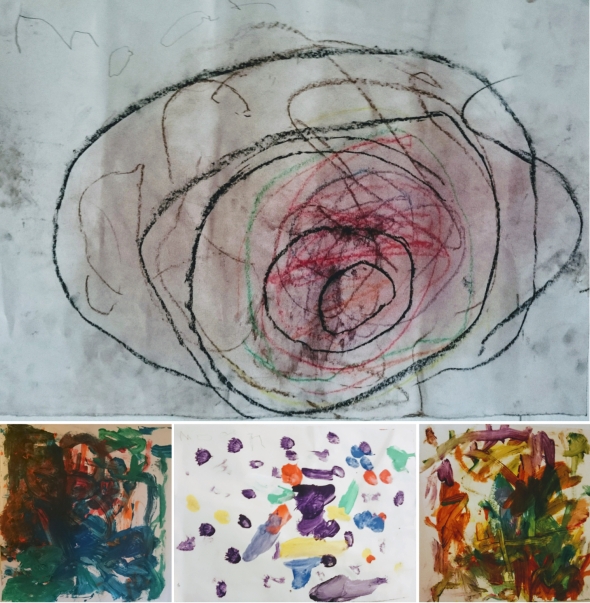 noah, agnes, noah, agnes (pastel and paint on paper) 2018
noah, agnes, noah, agnes (pastel and paint on paper) 2018
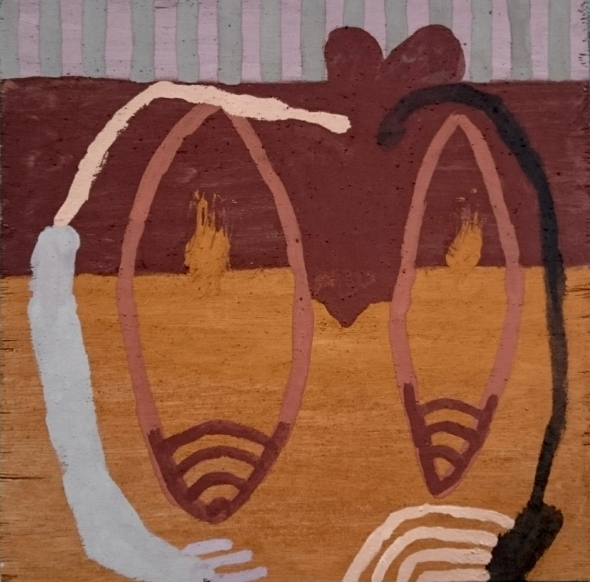 two heads (Cornish earth pigments on wood) © p ward 2018
two heads (Cornish earth pigments on wood) © p ward 2018
 eventual remediation (Cornish earth pigments on wood) © p ward 2018
eventual remediation (Cornish earth pigments on wood) © p ward 2018
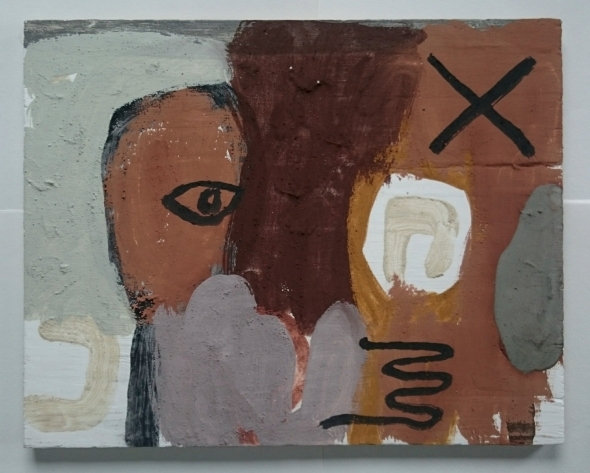 looking for love (Cornish earth pigments on wood) © p ward 2018
looking for love (Cornish earth pigments on wood) © p ward 2018
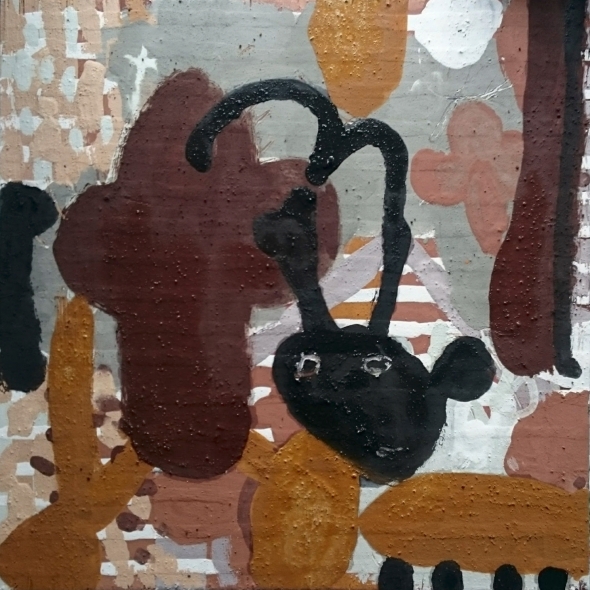 Cornish Folk Tale I (Cornish earth pigments on wood) © p ward 2018
Cornish Folk Tale I (Cornish earth pigments on wood) © p ward 2018
Professionally, I am working on an Arts Council National Lottery Project Fund proposal in association with Geevor Tin Mine to research the creative and educational potential of the pigments. Through recent projects and contact with the staff at the Mine I have started to appreciate and become really excited by the rich historical, geological, chemical and social provenance that the colours carry. After the far-reaching and ongoing success that Painting with Earth – North Devon has brought, let’s hope I will get some real financial support to enable the continuation of this rich seam of work ;-).
© P Ward 2018
painting a parish future – Pendeen in St Just, Cornwall
Posted: November 29, 2018 Filed under: activ8, eARTh, educ8 | Tags: arts research, Cornwall, earth pigments, eco art, Ecology, ecopsychology, Environmental art, indigenous culture, Interdisciplinarity, Mining, painting, Painting Together, Pigment, Visual arts 2 CommentsESRC Festival of Social Science, 10th November 2018
background
I met Dr Joanie Willett at a ‘Melting Pot’ event at Exeter University’s Environmental Sustainability Institute at Penryn Campus in Falmouth, Cornwall. The purpose of the event was to provide opportunities for cross-disciplinary collaborations. Dr Willett was fascinated by aspects of the geology behind earth pigments, particularly of those connected with mining waste, and of the potential for public engagement that my workshops provided. I was intrigued by Dr Willett’s studies around Parish Councils and how to promote public engagement in the political process, reminding me of conversations I had in Australia around the ecological basis of Aboriginal tribal councils.
After a further meeting, held as a walk along the ‘Tin Coast’ in West Penwith between Pendeen and Botallack, we decided to organize a public workshop exploring these principles. Funding was obtained from the Economic and Social Research Council and Exeter University as part of the Festival of Social Science, a national event making Social research accessible to the general public.
where the personal becomes POLITICAL: the idea
Our personal experiences, knowledge and perceptions of the places we live are all valid contributory factors to the cultural truth of a place. In Western democracies the starting point for policy decisions are ideally based in such cultural truths. Parish councils, of which there are some 10,000 in the UK, are the gathering places for the diverse cultural perception of our local communities. Beyond this such cultural perceptions are strongly influenced, if not determined, by the geographical identity, the physical ecology and resources, of a place.
painting a parish future offers a creative space to cultivate and share personal experience, knowledge and future visions of the places that we live.
It is hoped that the creation of such a space within a working Parish may encourage a spirit of commonality and cooperation within groups that may too easily become competitive and detached from the truth of a regions imminent ecology, in respect of all its inhabitants.
painting a parish futureis a collaborative research project led by politics lecturer Dr Joanie Willett and ecological artist Peter Ward in association with Exeter University’s Environmental Sustainability Institute. The project will utilize a shared knowledge of local political process and creative environmental engagement.
An initial enquiry will gather local people, parish councilors and experts to walk and share experiences and knowledge in a reflective process in the Parish of St Just in west Cornwall. The daylong event will culminate in a communal painting using gathered materials to express a shared vision of the future. The painting and further documentation of the event will be exhibited at the ESI at Penryn Campus and at a local venue in St Just Parish.
painting a parish futurewill run alongside ongoing national and local initiatives ‘Going Wild’ with Cornwall Council and the Cornwall Wildlife Trust and the St Just and Pendeen Neighbourhood Development Plan.
The project will provide a model for further actions in local communities across the UK, international research with Indigenous communities in Australia and the basis for an academic paper in relation to such activities, as well as a real focus for community action in the place it is performed.
in practice
The event was advertised locally in the Parish ‘Outreach’ magazine, through flyers in local shops and on notice boards and through personal invitation to relevant experts. It was hoped that we would have a group of about 20 people for the event. In practice, we were fortunate that a County Councilor expressed her interest from an early stage, inviting a simple presentation at a Town Council meeting in St Just to further promote the event. On the day, 2 people who had signed up did not show leaving us with a group of 7, including Dr Willett and myself. While the response was a little disappointing, and indeed raised a very important discussion regarding public engagement, the small number did allow for more focused time and intimate space for discussion and sharing and better engagement with the process.
Part of my personal motivation for the event was to begin to learn more about the place that I live. Both my own background research about the area and the process of organizing the event provided interesting insights into the present social dynamic and historical roots of the parish. Another part was to establish contacts within the community and with relevant organizations for future projects.
 Poster/invitation for painting a parish future – Pendeen in St Just; 7 Cornish pigments, earth colours used in communal painting © p ward 2018
Poster/invitation for painting a parish future – Pendeen in St Just; 7 Cornish pigments, earth colours used in communal painting © p ward 2018
Participants included an artist, a politics lecturer, an environmental educator and project manager, a childminder, County Councilor, Town Councilor and a geologist, providing the basis for lively, diverse and informed discussion throughout the day with many thoughts for positive action being shared.
The morning walk took us through the village of Pendeen to the recently restored leat (a community project initiated by a member of the group), through the historic mining community of Lower Boscaswell, to the medieval ‘holy’ well and then through remains of Geevor Tin Mine and ancient field networks down to the coast, before heading back to the Parish Hall for lunch. Conversation within the group flowed easily between the whole group and individuals and covered topics from local planning policy, local history and geology, the influence of the environment on agriculture, national environmental and political attitudes, interspersed with a shared appreciation of the natural world, and in particular the local environment. Lunch was a homemade vegetable soup, made using exclusively local produce from the community farm, along with local cheese and bread and a splendid array of cake.
Pendeen Parish Hall, photo courtesy J Willett
The process of painting (interesting for my part for the lack of ‘artists’ in the group) took participants a little out of their comfort zones but allowed us to ground our thoughts in a meaningful and enjoyable way. The pigments themselves offered further insights into the local environment, as well as paint making. The painting itself was structured through an approximation of the evolutionary process, starting with imagery around geology, then land use and flora and fauna and lastly human intervention. Despite the initial discomfort, participants recognized the value of the process, at whatever level individuals felt able to contribute, and enjoyed the end result.
painting a parish future – Pendeen in St Just, photos courtesy J Willett and M Ward
conclusion and further action
Despite the somewhat disappointing public response to the event, it was agreed that it had been a useful and inspiring day with everyone feeling they would use what they had learnt in some way. Some said they ‘had never participated in anything like it before’ and that it had revealed a new way of working in the public sphere. I was personally encouraged by how everyone got involved with the process and in particular how the act of painting with local pigments was enjoyed and valued.
As a facilitator, whenever I approach an event such as this I will necessarily fill my mind with any relevant information I wish to share and a structure I aim to run the day through. In practice, especially when working with adults, it is essential that such plans are held merely as guidelines and that the process and dynamic of the group are allowed to express themselves for a satisfactory outcome to be achieved. Indeed, it is inherent to the process that the day is allowed to progress organically within any practical limitations, such as time, space, numbers and sustenance, to be true to itself. What is exciting about such a process is exactly those surprises or unknowns that arise, leading us to new ideas and future actions.
Through contacts made at the Town Council presentation, it is hoped that the painting and research will be exhibited at St Just Library, while also being shared with the Town Council and Local Neighbourhood Development Plan as an example of public engagement. Discussion has already begun regarding further collaboration with Dr Willett with the possibility of developing the event in other areas. Business and public groups in the area have also approached me to run similar workshops for upcoming events.
painting a parish future– Pendeen in St Just, communal painting, earth pigments on board © p ward 2018
Thank you to everyone who participated in the event, for the support and interest of the local community and especially to Joanie for her contributions and collaborative insights.
© P Ward 2018
new home new earth
Posted: February 5, 2018 Filed under: eARTh | Tags: Art, Arte Povera, Arts, arts research, Cornwall, Cornwall Area of Outstanding Beauty, earth pigments, eco art, Ecology, Environmental art, Geevor Mine, Levant Mine, Mining, Pigment, Visual arts, West Penwith 2 Commentsdiscovering colour in west cornwall
 Pendeen, Trewellard, Boscaswell and Geevor Mine, Cornwall © p ward 2018
Pendeen, Trewellard, Boscaswell and Geevor Mine, Cornwall © p ward 2018
moving home is always an exciting (if not somewhat stressful) time for discovery, for exploration, for new knowledge and for refreshment of life paths. I have recently moved with my family from North Devon to West Cornwall, as far south and west as one can go in the British Isles (apart from the Isles of Scilly, of course). The move was made to connect with the flourishing and historic arts scene in the area – Newlyn and St Ives on the Penwith peninsula being significant places in British art history over the last few centuries. The area is also remarkable for the globally significant tin and copper mining industries that flourished during the nineteenth century providing a wealth of metal ores and new technologies that contributed to mining knowledge around the world. The industry has now all but died out, due to cheaper sources elsewhere, but has left its mark ecologically and architecturally to this rugged, wet and windy section of Atlantic coast.
 Sennen Cove, Cornwall © p ward 2018
Sennen Cove, Cornwall © p ward 2018
 Rainbow over Geevor Mine, Cornwall © p ward 2018
Rainbow over Geevor Mine, Cornwall © p ward 2018
 Phone Box collection, Trewellard, Cornwall © p ward 2018
Phone Box collection, Trewellard, Cornwall © p ward 2018
 Lamppost, Pendeen, Cornwall © p ward 2018
Lamppost, Pendeen, Cornwall © p ward 2018
 Leswidden block works, St Just, Cornwall © p ward 2018
Leswidden block works, St Just, Cornwall © p ward 2018
 ‘Montol’ Midwinter celebrations, Penzance, Cornwall © p ward 2018
‘Montol’ Midwinter celebrations, Penzance, Cornwall © p ward 2018
 Turning on the Mousehole Lights, Cornwall © p ward 2018
Turning on the Mousehole Lights, Cornwall © p ward 2018
having spent the last ten years intensively researching the geology, history and uses of earth pigments found in North Devon, and establishing an international reputation through it, it is quite nerve wracking to up sticks and start again. Added to this sense of newness, is that of the unfamiliar. North Devon is my mother’s family home and a region I have known all my life. While the wild and austere beauty of West Penwith is visually and culturally inspiring it will be a while before I feel it as my home, despite feeling very comfortable here, nestled in a cosy old granite cottage close to the north coast. However, the process of taking root has begun and exploration to reveal the individual peculiarities of my new home, and especially those qualities that appeal to my own nature, have gripped my thoughts and actions.
 Lanyon’s Quoit, Penwith, Cornwall © p ward 2018
Lanyon’s Quoit, Penwith, Cornwall © p ward 2018
 Merry Maidens stone circle, Penwith, Cornwall © p ward 2018
Merry Maidens stone circle, Penwith, Cornwall © p ward 2018
 Lanyon’s Quoit in the mist, Penwith, Cornwall © p ward 2018
Lanyon’s Quoit in the mist, Penwith, Cornwall © p ward 2018
within six weeks we have found four excellent and bold earth colours locally, associated with historic mining activities. We have revealed a dolmen in our living room as well as starting to visit the plethora of ancient megalithic sites in the area. The sea, the mist, the rocks and wind are ever present on this extreme peninsula, the most exposed place I have ever lived. Having studied for my MA in Falmouth and consequently visited the county on numerous occasions, I am vaguely familiar with the area and some of the sites of interest, but was unaware of the incredible natural and cultural richness it provides. The county of Cornwall is one of the few Celtic strongholds on the British Isles, with its own language and a pride in its unique history, both ancient and modern. This is evident in so many ways – its folklore, place names, wildlife, art and its connection to the sea and land. I am very excited to see how this feeds my own creative output.
 Levant mine entrance, Cornwall © p ward 2018
Levant mine entrance, Cornwall © p ward 2018
 Red ‘clay’ at Geevor Tin Mine, Cornwall © p ward 2018
Red ‘clay’ at Geevor Tin Mine, Cornwall © p ward 2018
 Bottallack Mines, Cornwall © p ward 2018
Bottallack Mines, Cornwall © p ward 2018
 Purple and red ‘clays’ at Levant Mine, Cornwall © p ward 2018
Purple and red ‘clays’ at Levant Mine, Cornwall © p ward 2018
 Leswidden China Clay Pits, nr St Just, and Spoil heaps at Tywarnhayle Mine, Porthtowan, Cornwall © p ward 2018
Leswidden China Clay Pits, nr St Just, and Spoil heaps at Tywarnhayle Mine, Porthtowan, Cornwall © p ward 2018
the pigments we have gathered so far include red and purple ‘clays’, residues from the slag heaps at Levant Tin Mine, apparently deposited alongside, and hence coloured by oxides within, the seams of black tin (casserite) found in cracks in the 340 million year old granite mass that forms the majority of landmass here. The huge forces, pressures and temperatures experienced as the molten granite forced its way through weaknesses in the overlying Devonian sediment created a wealth of opportunities for metallic minerals ores to form alongside metamorphic rocks. According to one source the area has some of the most varied and mineral rich geologies in the world! We have collected a yellow ochre-like residue from mine waste heaps further northeast at Tywarnhayle Mine, Porthtowan. The yellow deposit also contains fragments of ‘green’ rock that will be interesting to separate and hopefully use. The oldest China Clay pits, formed in lakes as eroded granite deposits, can also be found near St Just in Penwith with a wealth of local history and national significance. We have been given access to this beautiful smooth white clay by the present landowner, whose father spent some time working in the drying kilns on site during his youth. We are experimenting with different approaches to processing the raw pigments, relying on water extraction, sieving and drying, similar to historic methods of extracting ore, rather than the more physical drying and grinding that we employed with the very different pigments in North Devon. This is partly due to the different nature of the raw pigments but also as a safeguard against inhaling potentially dangerous bi-products of the mining residues, such as arsenic! We are presently seeking geologists to aid in our research.
 shapes, marks, patterns and forms, Cornwall © p ward 2018
shapes, marks, patterns and forms, Cornwall © p ward 2018
 textures and marks, Penwith, Cornwall © p ward 2018
textures and marks, Penwith, Cornwall © p ward 2018
As you can see, it’s all really exciting stuff. However, as yet, we are still to find a suitable workspace, tubs of pigment being stored and worked on convenient window ledges and in the cramped garden shed. But time will work its magic and the right space will reveal itself. We have already been made aware of a possible arts space development in old buildings at the entrance to the mining museum at Geevor mine in our village, as well as studio spaces associated with the established art schools of St Ives and Newlyn. Work still continues elsewhere too with talks and workshops coming up in North Devon and further afield in East Sussex, so all is good with the world. And all this while juggling childcare priorities and other homemaking eventualities. So, thank you to family and friends for your support during our transition and also to the warm welcome and help we have received from the local community. I am certainly looking forward to seeing how everything unfolds…
 Geevor Tin Mine, Cornwall © p ward 2018
Geevor Tin Mine, Cornwall © p ward 2018
 Levant Mine, Cornwall © p ward 2018
Levant Mine, Cornwall © p ward 2018
 Geevor and Levant mines, Penwith Heritage Coast, Cornwall © p ward 2018
Geevor and Levant mines, Penwith Heritage Coast, Cornwall © p ward 2018
© P Ward 2018
una nuova foglia si voltò/ein neues Blatt hat sich gedreht/une nouvelle feuille a tourné…
Posted: October 12, 2017 Filed under: activ8, eARTh | Tags: #GNAP France 2017, Arte Povera, earth pigments, Environmental art, painting, Pigment, Visual arts Leave a comment(a new leaf did turn)
paintings after GNAP France 2017
My time in France as part of the GNAP residency has left me inspired in many ways – through the people I met and energy exchanged, the places visited and the scale and scope of work achieved.
 danza/tanzen/Danse/dance, earth pigments on reclaimed wood © p ward 2017; a fischiare/Pfeifen/siffler/to whistle, earth pigments on board © p ward 2017
danza/tanzen/Danse/dance, earth pigments on reclaimed wood © p ward 2017; a fischiare/Pfeifen/siffler/to whistle, earth pigments on board © p ward 2017
Only just more than a fortnight has passed since my return and it has been quite a journey finding my way back to life ‘above the surface’, to ‘normal’ life. I have missed the people, the fun and sharing on such a multicultural, multilingual level, the singsong chatter, the banter, the partial misunderstandings and the poetry of ‘pigeon’ language. I have bemoaned the romance of life in another country and the space to create so utterly supported by the structure of the residency – we were very spoilt. My wings did truly spread. My hair did get utterly let down and shaken.
 le mani intrecciate/Hände verschlungen/mains enlacées/hands entwined, earth pigments on board © p ward 2017
le mani intrecciate/Hände verschlungen/mains enlacées/hands entwined, earth pigments on board © p ward 2017
But what is the meaning of experience if it cannot be carried forward in life, if we do not learn from it or use it in some way? On a personal and professional level the residency allowed me the confidence to see myself fully as an artist again, capable of working in an international arena. It provided me with the confidence to travel and communicate with others beyond my own cultural ecology. Through contact with other artists, more experienced or simply with different approaches and goals, I began to understand principles and pathways within my own practice (and that of others) that will help my work evolve and grow.
 un nuovo modo di parlare/eine neue Art zu sprechen/une nouvelle façon de parler/a new way to speak, earth pigments on reclaimed wood © p ward 2017
un nuovo modo di parlare/eine neue Art zu sprechen/une nouvelle façon de parler/a new way to speak, earth pigments on reclaimed wood © p ward 2017
I now aspire to make and show my work internationally as I begin to appreciate more fully the social and ecological significance of what I do, as well as the desire within myself to create and share my work as part of the global art network. The experience offered me new perspectives on my work in terms of materials, context and application, as well as a feast of new imagery, ideas and stories to share. Through language limitations I started to learn to describe my work more simply and universally.
 lupo/Wolf/loup/wolf, earth pigments on board © p ward 2017
lupo/Wolf/loup/wolf, earth pigments on board © p ward 2017
Here is a selection of paintings completed since returning home inspired by my time on GNAP France 2017. I have included titles in four European languages (via Google Translate) to acknowledge and celebrate my geographical and shared cultural identity.
 il pipistrello e la leper/die Fledermaus und der Hase/la chauve-souris et le lièvre/the bat and the hare, earth pigments on board © p ward 2017
il pipistrello e la leper/die Fledermaus und der Hase/la chauve-souris et le lièvre/the bat and the hare, earth pigments on board © p ward 2017
 sorriso dentro/innen lächeln/sourire à l’intérieur/smile inside, reclaimed wood and rock © p ward 2017; una capra in turbolenza/eine Ziege in Aufruhr/une chèvre dans la tourmente/a goat in turmoil, earth pigments on board © p ward 2017
sorriso dentro/innen lächeln/sourire à l’intérieur/smile inside, reclaimed wood and rock © p ward 2017; una capra in turbolenza/eine Ziege in Aufruhr/une chèvre dans la tourmente/a goat in turmoil, earth pigments on board © p ward 2017
Thank you again to everyone involved. I hope that the friendships and professional relationships created will enable many new adventures in the future.
 diversità culturale/kulturelle Vielfalt/diversité culturelle/cultural diversity, earth pigments on reclaimed wood © p ward 2017
diversità culturale/kulturelle Vielfalt/diversité culturelle/cultural diversity, earth pigments on reclaimed wood © p ward 2017
© P Ward 2017
Back to eARTh (well, nearly!)
Posted: September 28, 2017 Filed under: eARTh, educ8 | Tags: Arte Povera, Bideford Black, children's art, earth pigments, eco art, ecopsychology, Environmental art, North Devon, painting, Pigment, Visual arts 1 CommentGreat Torrington Bluecoat C of E Primary School Workshops 27917
After flying high in the caves of France with some wonderful fellow artists, it was back to the ‘day job’ running a series of painting with eARTh workshops for 8-9 year olds at a local school in North Devon. The school was studying the ‘Stone Age’ and invited me in to share how people would have made paint in the long distant past and learning a bit about local geology.
After getting through the space age security system, face recognition cameras and all, deemed necessary at schools these days, I was, to my surprise, confronted by a school (teachers too) dressed as stone-age people! Whether bad hair, bad teeth and an abundance of nylon leopard-print was apparent in the caves of our ancestors (or whether the people of Great Torrington always dress like this) I would not like to say, but we all had a fantastic day making paint and painting (and messing up the carpet). Sadly, the teachers were surprised by how the children handled paint, art activities being totally side-lined in our present education system for more ‘vocational studies’ (at 8-9 years old ???!!!). However, it was great to offer the opportunity to do some thing environmental and creative. I asked the children to paint pictures of local wildlife – the prevalence of mammoths and sabre-toothed tigers was again a bit of a shock!? I will have to be more careful when walking on Torrington Common in the future.
The results were fantastic – thank you to the children for working so hard and teaching me so much…





 earth pigment paintings courtesy of Great Torrington Bluecoat School yr4 © eARTh 2017
earth pigment paintings courtesy of Great Torrington Bluecoat School yr4 © eARTh 2017
© P Ward 2017
Global Nomadic Art Project France 2017
Posted: September 27, 2017 Filed under: A BUNDLE OF STICKS, activ8, eARTh, the ash tree, Uncategorized | Tags: #GNAP France 2017, Arte Povera, Arts, arts research, collaboration, earth pigments, eco art, Ecology, Environmental art, Land Art, painting, Pigment, Visual arts 1 CommentArt Underground
 Residency group photo © GNAP France 2017
Residency group photo © GNAP France 2017
In early September I was fortunate to be among 22 international artists (from as far afield as South Korea, USA, India, New Zealand, Iran, Australia, Germany, Italy and France) warmly invited to Doué en Anjou in the Saumur Region of the Loire, France, to live and work amongst the plethora of caves that sit just beneath the surface. During the 10 day residency we were taken to troglodyte habitations, sarcophagus workshops, a zoo, a farm, a quarry, a woodland lake, art galleries, champagne cellars, vineyards and restaurants as well as sites along the Loire to create site-specific nature-based works. Final installations and video works were presented to an audience of 900 sponsors, local school children, press, dignitaries and the general public at Les Perrieres cave centre as part of the national Heritage celebrations. The residency, part of a series throughout Europe organized by YATOOi during 2017, was a wonderfully rich and playful cultural exchange supported by local generosity and inspiring an outstanding depth and variety of work reflecting the diverse backgrounds and environments shared.
 residency visits and hospitality © GNAP France 2017
residency visits and hospitality © GNAP France 2017
 residency site visits © p ward/GNAP France 2017
residency site visits © p ward/GNAP France 2017
 Magdelene Dolmen, GNAP France © p ward 2017
Magdelene Dolmen, GNAP France © p ward 2017
Despite the difficulties of language good friendships were established through common acts of work and play, through the joyful sharing of cultural peculiarities and through shared experience, all helped by a plentiful supply of local wine and champagne – we were in France after all! The generosity and openness of the local people, businesses and sponsors to a group of unknown artists descending into the area was quite remarkable. All events within the residency – openings, introductions, public presentations and the final exhibition – were all well and enthusiastically attended. Much credit should of course be given to the residency organizers (Olivier Huet and Magrit) who brought such bounty to the group and facilitated the residency in a wonderfully warm, relaxed and friendly manner. As you can see from the program we were kept very busy during the residency adding an enjoyable intensity to proceedings.
 residency program © GNAP France 2017
residency program © GNAP France 2017
 Les Perrieres, cave visitor centre © Sally Kidall 2017
Les Perrieres, cave visitor centre © Sally Kidall 2017
The work, framed within the residency as ‘Nature’ or ‘Land’ Art, was created during short ’workshops’ (visits) to places of interest or relevance to the theme of ‘Art Underground’. It was hoped that through simple introductions to the history, ecology and geology of the places we would build up a sense of the extraordinary dual (underground/surface) character of the region. Throughout the first week we all developed a better relationship to and sense of the materials prevalent and formative to the area. This knowledge allowed us to slowly form ideas for a final piece to be installed or shown within or near the cave complex at Les Perrieres where we were so comfortably accommodated. The cave complex is a fantastic attraction in itself, catering for public and school groups, having employed artists to interpret and enrich the network of caves carved from the earth for building materials over the last 500 years. The experience of spending such a lot of time underground, to emerge intermittently into the ‘light’, was at once quite disorientating and somehow reassuring, and also hard to describe. (Returning home to a small house in the English countryside, with windows overlooking a valley, certainly felt very strange.)
 Seven Bodies, GNAP France © Atefah Khas 2017
Seven Bodies, GNAP France © Atefah Khas 2017
 peter ward, GNAP France workshop installations © p ward 2017
peter ward, GNAP France workshop installations © p ward 2017
As an artist (maybe overly) academically acquainted with the various forms and history of environmental art it was fantastically refreshing to simply make – to spend time with others in an environment, to explore new and familiar materials in a different context and to enjoy the varied processes employed by the other artists. The care and attention both in making, recording and documenting that was adopted by many was an inspiration. An amazing skill for choosing sites for installations where they may be viewed and documented best was also apparent, as was an enviable dexterity with digital editing and animation among the group.
 ombre, GNAP France © Valeria Codara 2017
ombre, GNAP France © Valeria Codara 2017
 Marc Avery, Majid Ziaee, Donald Buglass, Valeria Codara, Joël Thépault © GNAP France/Joël Thépault 2017
Marc Avery, Majid Ziaee, Donald Buglass, Valeria Codara, Joël Thépault © GNAP France/Joël Thépault 2017
 Pierre Guilloteau, Joël Thépault, Isabelle Aubry, Roger Rigorth © GNAP France 2017
Pierre Guilloteau, Joël Thépault, Isabelle Aubry, Roger Rigorth © GNAP France 2017
 Essentials Atefeh Khas/Roger Rigorth, Joël Thépault © Atefeh Khas/Roger Rigorth/Joël Thépault/GNAP France 2017
Essentials Atefeh Khas/Roger Rigorth, Joël Thépault © Atefeh Khas/Roger Rigorth/Joël Thépault/GNAP France 2017
 Gunjan Tyagi (and friends) © GNAP France 2017
Gunjan Tyagi (and friends) © GNAP France 2017
 Sally Kidall/Cherie Sampson, Pascale Planche, Soon-im Kim, Lee Sun-ju, Aarti Zaveri © GNAP France 2017
Sally Kidall/Cherie Sampson, Pascale Planche, Soon-im Kim, Lee Sun-ju, Aarti Zaveri © GNAP France 2017
 Ahmad Nadalian, Roger Rigorth, Pascale Planche, Patrick Tagoe-Turkson, Gunjan Tyagi, Ute Ritschel © GNAP France 2017
Ahmad Nadalian, Roger Rigorth, Pascale Planche, Patrick Tagoe-Turkson, Gunjan Tyagi, Ute Ritschel © GNAP France 2017
 Public Presentations, Philippe Noiret Theater of Doué-en-Anjou © GNAP France 2017
Public Presentations, Philippe Noiret Theater of Doué-en-Anjou © GNAP France 2017
 martyr, objets trouvé, © p ward 2017
martyr, objets trouvé, © p ward 2017
The lack of academic analysis and critique, whether by design or through language difficulties, was simply refreshing. While Land Art or Nature Art may be acknowledged within an art historical context it is often totally dismissed (for which I have been guilty) as a relevant form or practice by more ecologically/socially engaged contemporary artists. For example, Richard Long is often criticized for simply taking formal and conceptual ideas out of the gallery or bringing ‘natural’ materials back in, while Andy Goldsworthy overly-aestheticizing Nature, without acknowledgement of any political issues relevant to subject, material or space, and Robert Smithson for the use of massively macho machinery to make vast changes to a landscape without consideration for ecological consequences. I now personally appreciate all as parallel and historical aspects to all work of and about the environment – Art does not always have to be so overtly political after all, working intrinsically and subliminally within culture as a whole.
 oP77, earth pigments, GNAP France © p ward 2017
oP77, earth pigments, GNAP France © p ward 2017
The experience of GNAP France has given me a fresh perspective on my own prejudices, reiterating the value of personal tactile experience and expression within an environment, offering the opportunity to celebrate and share aspects of nature that may often go unobserved on both a minute and architectural scale, as well as space to develop a deeper sense of oneself within Nature. It is all a learning process. The residency offered such a space to the artists with little pressure to produce but simply to participate – to make contacts, to observe and to share within an international setting: something many of us seldom have the chance to enjoy. In the words of Italian artist, Valeria Codara, “It is only when we open ourselves to others that new ideas can emerge” (one of the few political sentiments expressed towards any of the work during the residency). Whether the individual works had ‘value’ in a social or ecological sense beyond the artists’ experience is always debatable, but it cannot be denied that the creation and participation in the whole experience was a rich and deeply transformative process.
 portant un paquet de bâtons sur les bords de la Loire, GNAP France © peter ward 2017
portant un paquet de bâtons sur les bords de la Loire, GNAP France © peter ward 2017
 peinture d’arbres, GNAP France © peter ward 2017
peinture d’arbres, GNAP France © peter ward 2017
The group of artists came from quite different creative backgrounds, culturally and professionally. We were also at various stages in our careers, the GNAP France residency offering differing possibilities for each of us. International networking, including the chance to really meet people we were otherwise only aware of online, was a key element as well as an international flavour to add to our profiles. Work-wise, while many of us approached each site afresh, many brought signature themes and forms to their responses. French artist Pierre Guilloteau brought along his deconstructed ‘wooden ball’ to reconstruct at various sites to great affect as part of his ongoing Longitude 0° project. Others created simple animations or filmed and produced performance pieces – quite a feat in such short periods of time. Some work was monumental in scale some definitely quite ethereal. Some worked with others, some alone. Thankfully there was a fair share of humour too.
 presse à la terre; bétail grotte, GNAP France © peter ward 2017
presse à la terre; bétail grotte, GNAP France © peter ward 2017
Despite a renewed appreciation of the craft, delicacy and aesthetic appeal of some of the more ethereal sculptural pieces my own work remained closely linked to a sense of our contemporary global situation. I certainly played within the aesthetics of unfamiliar materials but feel my stronger works expressed Nature not as a pristine, balanced, elemental world but as a turbulent shifting ecology within which humankind plays an often provocative and sometimes frivolous role (if we are willing to get the joke!?). During the week I began to recognize patterns emerging in my practice. Ways in which I become attuned to a landscape, such as gathering sticks or forming balls from soil, from which the work would develop. There was often a sense of ritual to my process, acknowledging elemental forces within each installation. There was a sense of passing to the final pieces, suggestions of something that had happened to which others were witness, often tinged with sadness and destitution, sometimes with joy. I started to understand the importance of narrative within my work (thank you Sally).
 perdant un jeu, objets trouvé, GNAP France © peter ward 2017
perdant un jeu, objets trouvé, GNAP France © peter ward 2017
For my own final piece, en passant par (passing through), I secured a large cave between two quarries. I was personally drawn to the combination of contemporary objects, surfaces and detritus as well as an abundance of usable natural materials in the space. My intention was to create an immersive experience using pigments, objects, imagery and ideas I had gathered throughout the residency. As an artist working with natural materials and pigments I am often forced to question or recognize the connection between cave art and graffiti. The space and residency offered an excellent opportunity to explore this more fully. I hoped to create a sense of the ‘artist’ passing through, a ‘nomad’, using the cave as a temporary habitation and workspace. Also to highlight the imaginative possibilities of the shapes, textures and structures already evident in the space through a minimal intervention of mark-making and objects. For me it was the largest and most ambitious project I have attempted to date. Thankfully it was well received by fellow artists and the public.
 en passant par, cave installation (detail), objets trouvé and earth pigments, GNAP France © peter ward 2017
en passant par, cave installation (detail), objets trouvé and earth pigments, GNAP France © peter ward 2017
 en passant par, cave installation (detail), objets trouvé and earth pigments, GNAP France © peter ward 2017
en passant par, cave installation (detail), objets trouvé and earth pigments, GNAP France © peter ward 2017 en passant par, cave installation (detail), objets trouvé and earth pigments, GNAP France © peter ward 2017
en passant par, cave installation (detail), objets trouvé and earth pigments, GNAP France © peter ward 2017
GNAP France is certainly an event I will never forget: as a time of learning, living and working on many new levels and having loads of fun with some beautiful new friends, rejuvenating my confidence, ambition and motivation as an artist. I can only thank all those involved – artists, organizers and sponsors – for their generosity in creating such an incredible encounter.
Thank you all for welcoming me so wholeheartedly to the GNAP family.
© P Ward 2017
__________________________________________________________________
GNAP France 2017 was curated by Olivier Huet (association Cranberry) www.gnap-france.fr
List of artists: Isabelle Aubry (France), Marc Averly (France), Claudette Besnard (France), Donald Buglass (New Zealand), Karin Chopin (France), Valeria Codara (Italy), Pierre Guilloteau (France), Atefeh Khas (Iran), Sally Kidall (Australia), Kim Soon-im (South Korea), Lee Sun-ju (South Korea), Ahmad Nadalian (Iran), Pascale Planche (France), Joël Thépault (France), Roger Rigorth (Germany), Ute Ritschel (Germany), Cherie Sampson (USA), Patrick Tagoe-Turkson (Ghana), Gunjan Tyagi (India), Peter Ward (UK), Aarti Zaveri (India), Majid Ziaee (Iran).
sponsors, GNAP France 2017
(Images are from my own collection or made available to me by request or through Yatoo Gnab Facebook pages. All images and works retain copyright to the artist and Yatoo GNAP. I hope I have mentioned everybody? Apologies for so many pictures of my work but hey!…:-))

